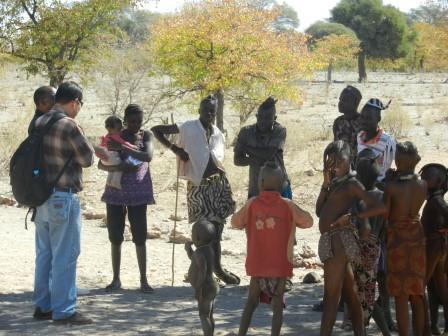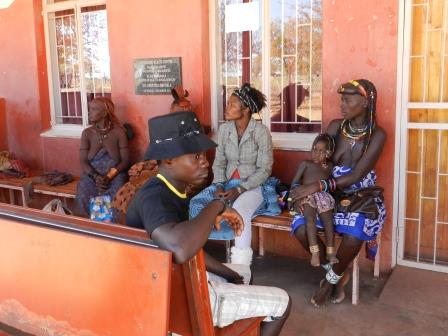27th August 2013 Windhoek, Namibia
Visiting drought stricken areas in northern Namibia
Namibian President Hifikepunye Pohamba declared a national emergency on 17 May in response to the country’s failed rains and worsening drought situation. An estimated 330,000 people have now been classified as food insecure – 14 % of Namibia’s total population of 2.3m, with an additional 447,577 classified as moderately food insecure.
The drought hit especially hard in Namibia’s north west Kunene Region, which had suffered two years of lack of rain. Some areas have already seen increased admissions for cases of paediatric malnutrition and a total of 46 malnutrition-related deaths had been recorded by July this year.
Kunene was one of the few regions that I had not managed to travel to in my two years here in Namibia so this month I travelled north to join UNICEF and Red Cross colleagues to visit some affected areas and see what assistance British aid money was helping to provide through our sizeable contributions to such international organisations.

Leaving the region’s capital Opuwo, the effect of the drought was immediately apparent in the wider Opuwo District. The rural land was completely parched – thick red sand dotted with thorn bushes and scrub – livestock and herd boys alike seeking shelter under occasional trees and no surface water in evidence anywhere, as is typical here.
Our first stop was at Omungeti village (Epupa Constituency) where we called in on Ms Tonata, a health extension worker, who was providing basic medical support for the Himba villagers. The Himba live almost entirely in their traditional areas in the remote Kaokoland of Kunene, wearing animal skins (skirts, loin cloths and head dresses) and often elaborate jewellery made from copper wire.
Cattle are central to their way of life, with the size of herds indicating wealth and prestige, necessitating a nomadic existence searching for pasture, particularly in times of drought. Ms Tonata reported that the villagers were being forced to migrate to find grazing land but no cattle had yet died. Malnutrition did not appear to be an issue amongst the active children we found at the site, who lived largely on a basic diet of maize meal and goats’ milk.
The villagers’ traditional nomadic coping mechanisms were in evidence as many had moved on in search of food for their livestock and reduced the amount they ate. The site also boasted a working borehole pump that was being used to provide water for goats.

Further on at the Okangwati Health Centre, we got a better taste of the general health issues in the area and impact of the drought. Okangwati lies 100 km north of Opuwo, some 30 km from the border with Angola. A mix of 15 Himba, Herero and Timba women were sitting waiting for the services of the sole nursing Sister running the clinic when we arrived at 3pm.
The Sister told us she saw between 50-80 people each day. Most suffered from a mix of respiratory diseases (including pneumonia), diarrhoea and skin disorders exacerbated by the dry, dusty conditions. Really serious cases had to be referred to the hospital in Opuwo.

The Sister complained that a lack of hygiene remained a continual challenge in the local communities. Given the arid conditions and traditional practices, Himba women never bathe and use herbs to cleanse themselves. They rub a scented ochre and animal fat mixture into their skin and hair to maintain their distinctive rich red brown natural covering.
She reported that the extreme drought was also exposing problems of malnutrition and worried that the situation would get a lot worse if the rains failed to arrive this December.
My UNICEF colleague, Dr Myo-Zin Nyunt, Chief Maternal, Child Survival and Development officer, updated me that Namibia’s 52% rate of open defecation exacerbated health problems. There were no toilets working at the health centre we visited, forcing waiting patients to use the bush, as is so common in Namibian rural areas.
Luckily the area was not registering any cholera cases, which also pose a risk when the rains finally arrive, and the Sister reported that there weren’t high incidents of malaria.

The UNICEF team had not yet seen large numbers of malnutrition cases in the area but everything hinged on whether the rains materialised. Dr Myo-Zin noted that Namibia already had a 29% stunting rate for children nationwide due to high malnutrition rates in rural communities in normal conditions.
Many children benefit from government supported school feeding programmes that supply pupils with at least one meal of maize porridge at school each day but this all depends on supplies reaching schools in emergency conditions. If they do not then school attendance can be expected to drop as children are dispatched to scout for good pasture, which is another challenge.
Many children survive with their grandparents, who support large numbers of young relatives on small pension grants, due to the high teenage pregnancy and HIV Aids infection rates. Even if they go to school, only 78% of schools have some type of sanitation facilities and 41% of schools remain without access to a water supply. Health and education challenges continue to abound in the Land of the Brave 23 years on from Independence.
What I saw in the north was extremely sobering and we will continue to keep a close watch on developments. The UN is actively monitoring acute malnutrition amongst children under 5 and pregnant women. UNICEF is partnering with the Namibian Red Cross to provide funding and technical support for the training of volunteers in some of the most affected regions, including Kunene.
The Namibian government has also initiated a range of response activities, including the provision of food rations through regional councils and drilling of new boreholes for water. It is developing a comprehensive response plan with donor help, including the placement of an expert provided by the European Union in the lead ministry handling disaster response.
The EU, UN and other partners that the UK provides its assistance via will continue to work in support of the government’s efforts. In the meantime, unlike in the British Isles, we all continue to hope for rain here.